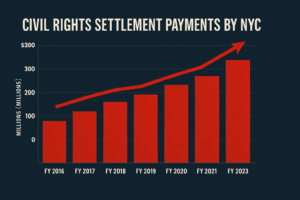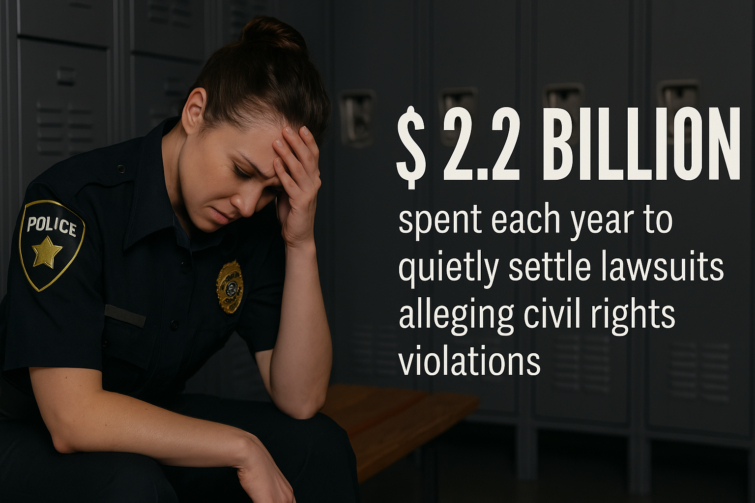Every year, billions of taxpayer dollars are quietly used to settle lawsuits involving civil rights violations committed by public entities. From city police departments to state correctional facilities and federal institutions, these settlements cover claims of sexual harassment, racial and gender discrimination, retaliation, excessive force, and other workplace and constitutional abuses. The public funds them—but rarely discloses to it.

No federal system requires public agencies to report when they resolve civil rights complaints. No standardized format for tracking whether the same officers or supervisors are repeatedly named. There is also no transparency about disciplinary actions—if any—taken after settlements. Finally, there is no insight into whether survivors and whistleblowers were silenced, demoted, or pushed out.
This is not merely a policy gap. It is a systemic failure of governance. When misconduct is normalized, accountability is absent, and taxpayer dollars fund silence, the cost isn’t just fiscal—it is moral, institutional, and societal.
Structural Blind Spots, Real-World Consequences
We’ve seen this pattern repeatedly:
A decorated NYPD captain publicly alleges sexual harassment and retaliation by senior leadership. Her claims become public only because she refuses to sign a nondisclosure agreement.
Officers in multiple jurisdictions accuse colleagues or supervisors of racial, gender-based, or sexual misconduct—only for the details to be buried in sealed settlements.
Whistleblowers report wrongdoing internally and face retaliation, reassignment, or constructive termination.
The damage extends far beyond these individuals. Hidden settlements protect repeat offenders, weaken reform efforts, and corrode public trust. And yet, this institutional opacity persists.
No Meaningful Oversight—Yet
While the Equal Employment Opportunity Commission (EEOC) requires public employers to submit demographic data through EEO-1 and EEO-4 reports, these tools offer no insight into what happens after those employees are hired. There’s no federal mechanism to track civil rights complaints, litigation outcomes, or misconduct-related public spending.
Despite urgent findings from the U.S. Commission on Civil Rights, the Government Accountability Office (GAO), and multiple state auditors, there has been no nationwide mandate to highlight these liabilities.
That must change.
A Concrete Solution: The Proposed Executive Order
In response to this longstanding blind spot, I have drafted a model Executive Order titled “Promoting Transparency in Civil Rights Settlements Involving Public Entities.” The Order establishes a Civil Rights Liability Disclosure Program that would:
Require biennial reporting by public entities with 100+ employees on all civil rights settlements and judgments, disaggregated by violation type, protected class, perpetrator rank, and employment outcome.
Include defense cost estimates, legal fees, and internal or external counsel hours.
Launch a centralized, publicly accessible database, maintained by the EEOC and DOJ, with searchable data, interactive dashboards, and implementation scorecards for each reporting entity.
Provide mandatory whistleblower protections, including anti-retaliation policies, internal complaint mechanisms, and annual reporting on whistleblower activity.
Encourage trauma-informed survivor protections, with model guidance on confidentiality, advocacy access, and mental health referrals.
Implement a pilot program with the 25 largest municipal law enforcement agencies, followed by a nationwide rollout after a 24-month review.
Require recertification audits every 2–4 years to maintain eligibility for federal grants and law enforcement accreditation.
Create a Joint Civil Rights Liability Oversight Task Force (co-chaired by EEOC and DOJ) to monitor compliance, recommend improvements, and report annually to the President and Congress.
Why an Executive Order—and Why Now?
Executive action can lead in the face of legislative inertia. This EO does not require new appropriations or legislation. It builds on existing EEOC and DOJ authorities and aligns with established transparency principles already used in federal contracting, environmental disclosures, and securities regulation.
Importantly, this is not about punishing public servants. It’s about aligning civil rights enforcement with fiscal responsibility. The public already tracks who gets hired. We must now track what happens when those employees are harmed.
Transparency isn’t a weapon—it’s a tool. It deters misconduct, surfaces institutional patterns, and allows meaningful reform to take root. It ensures that taxpayer dollars aren’t quietly used to fund the concealment of civil rights violations.
The Time for Silence Is Over
We cannot continue treating civil rights settlements as an afterthought buried in budget spreadsheets. We cannot allow survivors and whistleblowers to be punished while institutions avoid scrutiny. And we cannot continue spending billions in public funds on liabilities that no one is required to explain.
This Executive Order won’t fix everything. But it will do something that has long been missing: make the cost of misconduct visible—and ensure that what we spend is finally matched by what we learn.
Eric Sanders, Esq. is a New York-based civil rights attorney and the president of The Sanders Firm, P.C. He has represented hundreds of clients in litigation involving police misconduct, discrimination, and retaliation. He advocates for government transparency, survivor protection, and civil rights enforcement through executive, legislative, and institutional reform.
Read the Proposed Executive Order





